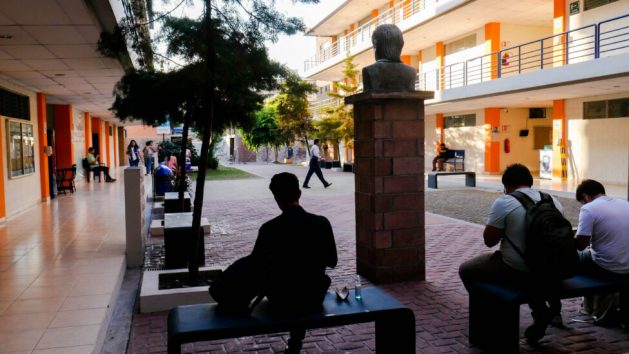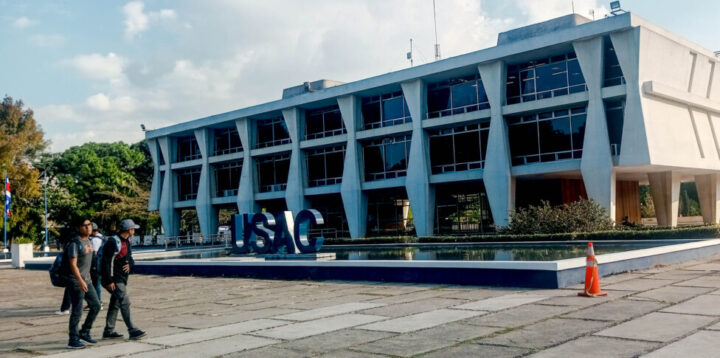Higher Education in Central America: Poor Quality and Unaffordable for the Poor

SAN SALVADOR, Jan 30 (IPS) - Decades of civil wars and a lack of long-term public education policies, among other problems, have made higher education in Central America precarious and costly in general.
In this region, made up of Belize, Costa Rica, El Salvador, Guatemala, Honduras, Nicaragua, and Panama, home to some 50 million inhabitants, the quality of education offered by public and private universities is poor, while costs are high even for those who can afford them.
Lagging behind
One way to measure the quality of higher education is through scientific production, which is almost nil in Central America.
"Higher education in Central America lags far behind in the scientific field," Óscar Picardo, director of the Institute of Sciences at the private Francisco Gavidia University in El Salvador, told IPS.
To illustrate, Picardo pointed to the few patents or research products registered as their own creations by Central American universities, both public and private, in comparison with institutions in the rest of Latin America.
For example, he said, universities in Colombia have produced around 400 patents and Chilean universities around 800, while in Central America only the public University of Costa Rica (UCR) has produced 44.
In fact, two Costa Rican institutions stand out the most in the region: the UCR and the public Tecnológico de Costa Rica.
"We have very limited budgets for research, for attracting human talent, for retaining doctors, so we are left with a very complicated scenario," Picardo said.
Investment in infrastructure has also been deficient, something that is quite clear to students in the region.
"The teachers have the knowledge, but the university falls short in technology, there is a lot of precariousness in that area," Karla Rodas, a Salvadoran journalism graduate from the public University of El Salvador, told IPS.

Rodas, 30, visited the university on Jan. 23 to ask about her graduation process, because due to different circumstances it has been postponed since she finished her studies in 2018.
With regard to the lack of investment in infrastructure, she added: "When I was at the university, there was a studio to produce radio programs, but it was definitely not the best equipment. There were no cameras either."
Yakeline Corea, a journalism student at the public National Autonomous University of Honduras, had a similar experience.
"The curriculum is fine, but the university does not have all the resources to have good infrastructure, good laboratories, suitable for the level that is being taught," Corea told IPS from Tegucigalpa, the country's capital.
The 21-year-old student said she decided to pursue a university degree because it opens a door to aspire to a better future.
Other young people must be creative in finding ways to attend university, such as Omar Hurtarte, a student of agricultural production systems engineering at the public San Carlos University of Guatemala, founded in 1676, which was the first in Central America and the fourth in the Americas.
Hurtarte, a resident of Mixco, 13 kilometers west of Guatemala City, the capital, said he had to set up a small business to support himself at the university, mainly because of the associated costs, such as transportation, food and internet.
Tuition is free at the region's public universities, even though they are mostly autonomous institutions, but there are many other costs associated with studying, especially for students who live outside the capital cities.
"It's a small enterprise. I got an oven to make pizzas and a large pot to make chicharrones (pork cracklings), here in Mixco, in order to finance my studies," the 36-year-old student said.
He added: "Through agronomy, I seek specialized, technological knowledge to contribute to the development of sustainable and efficient agricultural practices."
Hurtarte is one of the lucky few who can study at university in his country.
According to a study by the United Nations Educational, Scientific and Cultural Organization (UNESCO), in Guatemala, a country of 19.6 million people, only 2.6 percent of the population between 18 and 26 years of age has begun university studies and the percentage of students who complete two years or more is even lower.
Figures from the Central American Higher University Council indicate that there are 242 universities in Central America, including the Dominican Republic, a Spanish-speaking Caribbean island nation that is part of the Central American Integration System.
Of this total, 27 are public and 215 are private, confirming the marked trend of privatization of the sector, not only in the isthmus but also in the rest of Latin America, as pointed out in a report published in 2023 by the specialized education website Educ@.
This growing trend, according to another report published by Educ@, is observed in Brazil, Chile, Colombia, the Dominican Republic, Ecuador and El Salvador, while Cuba has exclusively public education. In Argentina and Uruguay, private higher education enrollment represents less than 25 percent of the total.

Poor management
Regarding the low quality of education in Central America, Juan Pablo Escobar, dean of the faculty of Humanities at the private Rafael Landívar University in Guatemala, said the situation is "sad and not very promising," especially in public institutions.
However, he pointed out that the shortcomings are not so much in the teaching itself, but in the disorderly management and the lack of public investment adequate to the needs, in the case of the public universities.
"I would not question the professionals and professors, but rather the structure, the logic behind it, the administration. The investment in public universities is not what would be expected, it does not achieve the desired impact," Escobar told IPS from Guatemala City.
The dean pointed out that in the region there are public and private universities that, despite the challenges to be overcome, are committed to training good professionals. Others teach from a purely technical point of view, while yet others see education merely as a business.
However, despite the bleak outlook, institutions are making efforts to improve. They have opted for international accreditation, an evaluation process carried out by specialized agencies that verify compliance with basic standards.
The social conflicts and civil wars in most countries of the region in the 1980s reduced the capacity of the States to invest in education.
And while Guatemala, El Salvador and Nicaragua were bleeding from their armed conflicts, Costa Rica experienced relative peace and was able to invest in health, education and other social areas, among other reasons that explain its progress in this area.
Both Picardo from El Salvador and Escobar from Guatemala concurred that in their countries there was no minimum political consensus to promote long-term educational strategies, but that this changed with the arrival of new governments.

High costs
Higher education is also expensive in Central America even for those who can afford it, and excludes the majority of the population, who have scarce resources.
"Unfortunately, higher education is not accessible to everyone, and this is unfair. A large number of graduates from public high schools do not have access to higher education," Oneyda Fuentes, a student of English language translation and interpretation at the private Evangelical University of El Salvador, told IPS.
Fuentes, 32 years old and in her second year of university, said she pays 100 dollars a month in tuition for online classes.
But last year, she explained, she took a course in person, which cost her 200 dollars a month, including related expenses, since she had to commute from her native Nejapa, a small town located 20 kilometers north of San Salvador, the country's capital.
Fuentes pays for her studies with the freelance work she already does as a translator and interpreter, having previously taken English classes.
At the beginning of 2024, the minimum wage in El Salvador, which varies according to economic sectors, is around 300 dollars a month, similar to those of Honduras and Panama, while in Guatemala it averages 400 dollars and in Costa Rica it is close to 700 dollars, according to official data from each country.
In this context, the cost of studying at university in Central America is high, even in the public universities, which by law are free. This is true especially for young people from rural areas who must rent an apartment and pay for food in the cities where the campuses are located.
"When I decided to study, I moved to Tegucigalpa, because if I had to travel from my village, it was a 6-hour bus ride," said Corea, the Honduran student, who is originally from El Membrillo in the municipality of Yaramanguila, in the southwest department of Intibucá.
She said she spends an average of 240 dollars a month to cover her expenses.
Although very few, in Central America there are also institutions that cater to upper-middle and upper-class students, which charge monthly fees of between 500 and 600 dollars.
At institutions focused on the middle classes, such as Rafael Landívar, run by the Catholic Society of Jesus, a degree in psychology can cost 275 dollars a month, said Dean Escobar.
"Higher education in Guatemala is very expensive. I say this as a PhD in education, as a dean and as a father, since I have two children already in university," he said.
For his part, Picardo, the Salvadoran academic, commented that in education there is the paradox that, in order for it to be of good quality, it has to receive funds from somewhere.
"You cannot sustain a campus, a good level teaching staff, with good level laboratories, without financial backing; quality education is expensive," he said.
© Inter Press Service (2024) — All Rights Reserved. Original source: Inter Press Service
 Global Issues
Global Issues